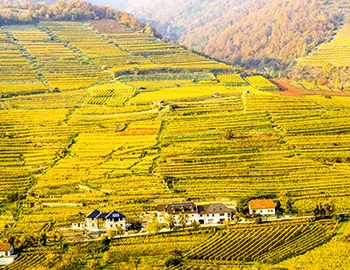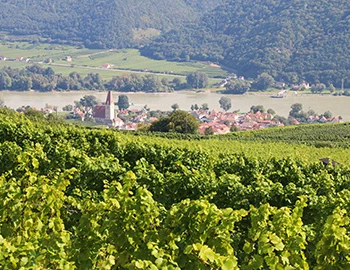Merlot Privatkeller 2019
QWt Niederösterreich, Schloss Gobelsburg, 750 ml

| Grape variety: | Merlot |
| Producer: | Weingut Schloss Gobelsburg |
| Origin: | Austria / Niederösterreich / Kamptal |
Description
The vines are grown on the Sachsenberg and are cultivated in the so-called "lyra" system, which ensures optimal ripeness. With a soft, opulent start, it lingers on the palate lined with fine sweetness extracts and ripe, smooth tannins. Its aroma ranges from rose and violet, currant jelly and cherry compote, Earl Grey tea, liquorice, mocha, cinnamon and cloves to black chocolate and cubeb pepper. You want to smell it forever and literally immerse yourself in the wine!
Attributes
| Origin: | Austria / Niederösterreich / Kamptal |
| Grape variety: | Merlot |
| Label: | Vegan |
| Ripening potential: | 3 to 10 years |
| Drinking temperature: | 16 to 18 °C |
| Food Pairing: | Moroccan specialities, Coq au vin, Saddle of lamb fillet with herb jus, Roast saddle of venison, Hot vegetable curries |
| Vinification: | fully destemmed, fermentation in wooden barrel |
| Harvest: | hand-picking, strict selection, in small boxes |
| Maturation: | in tonneau |
| Volume: | 13.5 % |
| Note: | Contains sulphites |
Merlot
Everybody’s darling
Merlot is the most charming member of the Bordeaux family. It shines with rich colour, fragrant fullness, velvety tannins and sweet, plummy fruit. It even makes itself easy for the vintner, as it matures without issue in cool years as well. This is in contrast to the stricter Cabernet Sauvignon, which it complements as a blending partner. Its good qualities have made the Merlot famous worldwide. At over 100,000 hectares, it is the most-planted grape in France. It also covers large areas in California, Italy, Australia and recently in Eastern Europe. The only catch is that pure Merlot varieties rarely turn out well. Its charm is often associated with a lack of substance. Only the best specimens improve with maturity. They then develop complex notes of leather and truffles. This succeeds in the top wines from the Bordeaux appellation of Pomerol and those from Ticino, among others.

Kamptal
Kamptal: a dynamic atmosphere north of the Danube
With an ever-growing number of leading vintners, Kamptal has increasingly stood out in recent years from the shadow of the legendary Wachau region. The basis for this are the various terroirs in this broad-ranging valley. At Loisium, the region is also host to a spectacular, futuristic visitor center.

Niederösterreich
Lower Austria: crus near and far from the Danube
Austria's largest state is also its largest wine region. 46,000 hectares are planted with vines in Lower Austria. It is a heterogenic wine region, consisting of eight wine growing areas. While white varieties like Grüner Veltliner and Riesling dominate in the areas north and west of Vienna, red varieties set the tone in the south and in the southeast (Thermenregion and Carnuntum). The internationally famous white crus from Grüner Veltliner and Riesling develop in the picturesque Wachau and Kamptal.

Austria
Austria – Sumptuous culture, accessible to all
Austria is characterized by unbelievable topographical diversity. A flat steppe in the east, forests and hills in the Alpine regions, wetlands and Mediterranean landscapes in the south. This in addition to a rich tradition and even greater love. It’s no surprise that the Romans found joy on this patch of Earth and cultivated wine growing. Austrian wine is not abundant, but it is high quality.



